The oldest part of the Principality of Monaco is Le Rocher de Monaco (aka the Rock of Monaco), a rocky promontory between Port Hercule and the Fontvieille district. This is the oldest part of the micro-state and the only district spared by developers. The old town of Monaco-Ville is home to political, judicial and religious institutions of Monaco. These are respectively the Prince’s Palace, the Town-Hall, the National Council (parliament), the tribunal, and the Catholic Cathedral.
Watch our short video on Monaco: Facts & Figures!
Plan your trip to the Principality of Monaco
- 🏨 Find the best accommodations in Monaco on Booking.com
- 🙋♀️ Get the PASS CÔTE D’AZUR and take your pick from more than 100 unique experiences on the French Riviera!
- 🏛 Visit the Oceanographic Museum on the Rock of Monaco
- 🎯 Take a guided hidden gem tour of Monaco
- 🏎 Enjoy an exhilarating Lamborghini Driving Experience from Monaco
- 🛥 Ride the Ferry from Nice to Monaco and back with this round-trip ferry transfer
- 🥗 Experience the culture and food of Old Nice on a 4-hour sightseeing and tasting tour
- 📚 Read the DK Eyewitness Provence and the Côte d’Azur Travel Guide
- 🤩 Get familiar with the French Riviera
- 🗺 Download the free City Map of Monaco
Where is the Rocher de Monaco?
The Rocher de Monaco is one of the four traditional districts of Monaco:
- Monaco-Ville: aka Le Rocher de Monaco. This is the old town, built on the Rock
- La Condamine: around the Hercules port
- Monte-Carlo : a residential and hotel area famous for its glittering casino
- Fontvieille: a district reclaimed from the sea in 1971
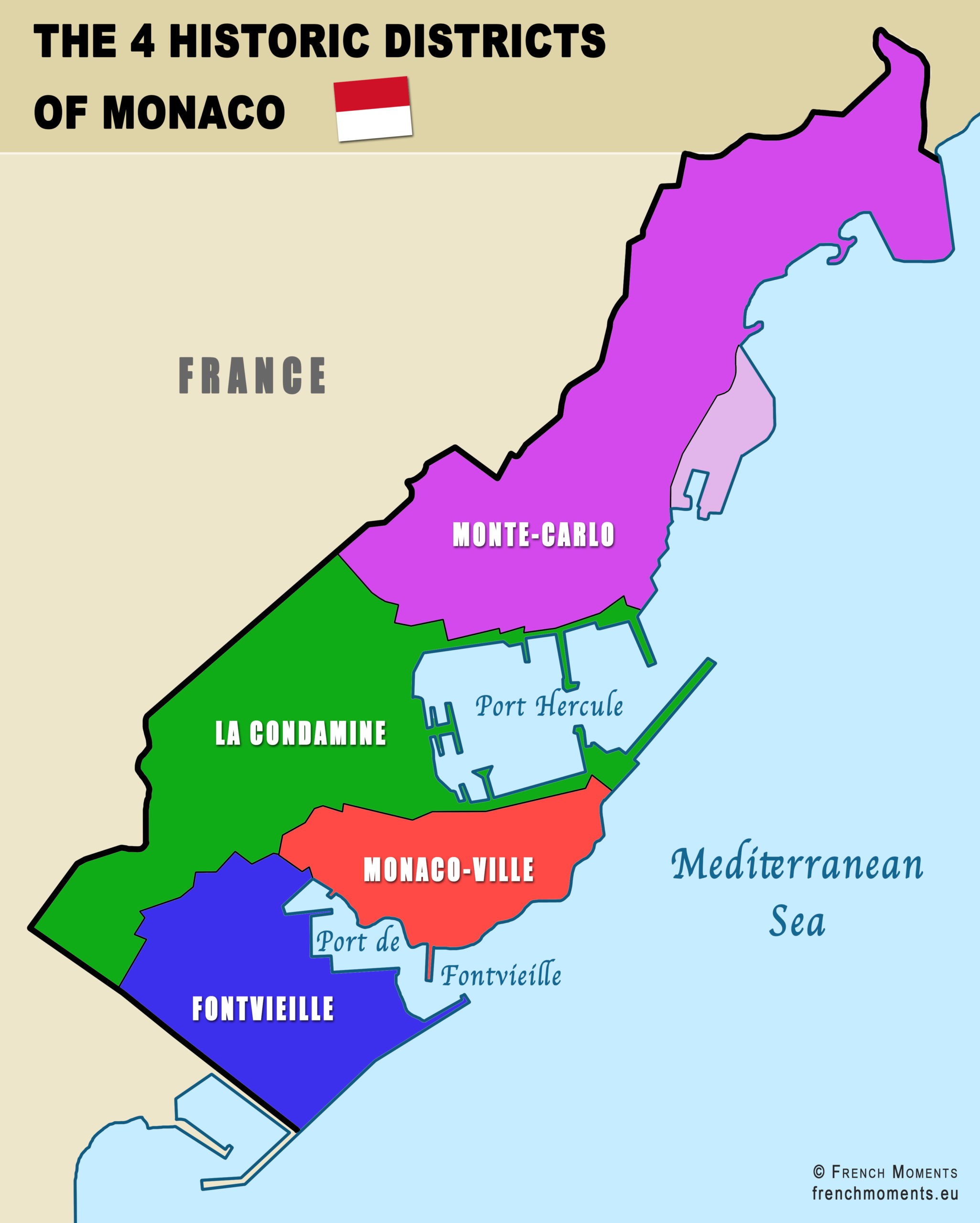
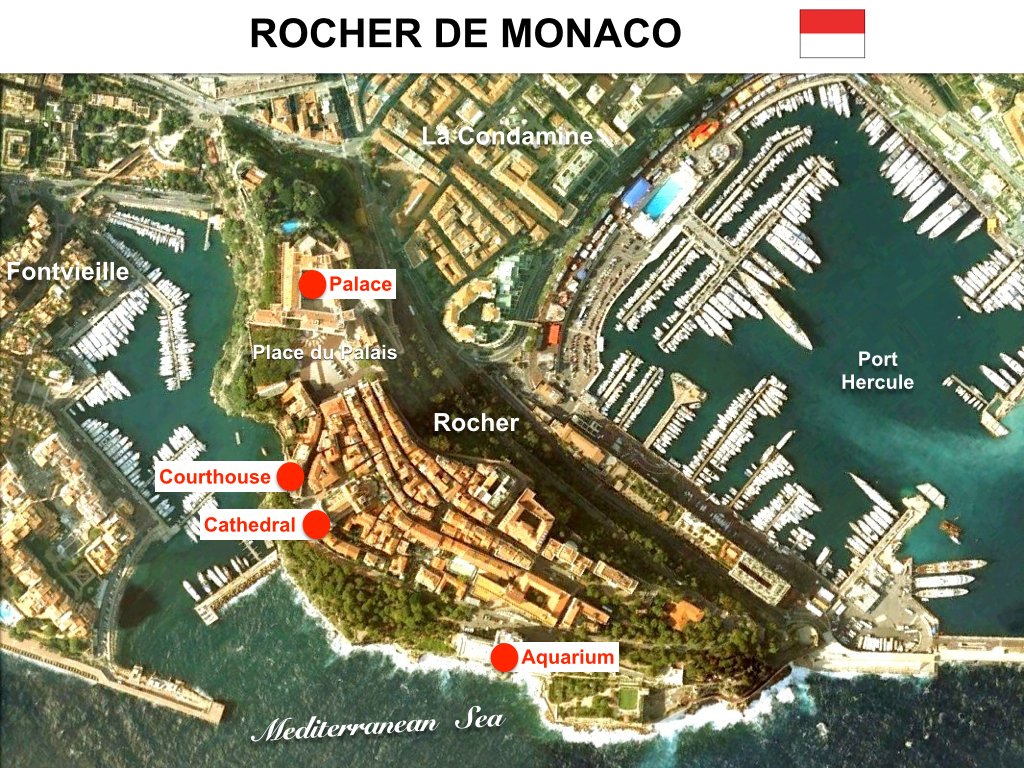
The Rock of Monaco in history
It was here that the Phocaeans of Massalia (now Marseille) founded the colony of Monoikos in the second century BC. The first inhabitants associated Monoikos with the demigod Hercules, who was worshipped under the name Hercules Monoecus.
On 10 June 1215, a detachment of Ghibellines led by Fulco del Cassello began building a fortress on the rock of Monaco. They aimed to make it a strategic military position and a means of controlling the region. They also established dwellings at the base of the Rock to support the garrisons. To attract the inhabitants of Genoa and the surrounding towns, they offered land and exempted newcomers from taxes.
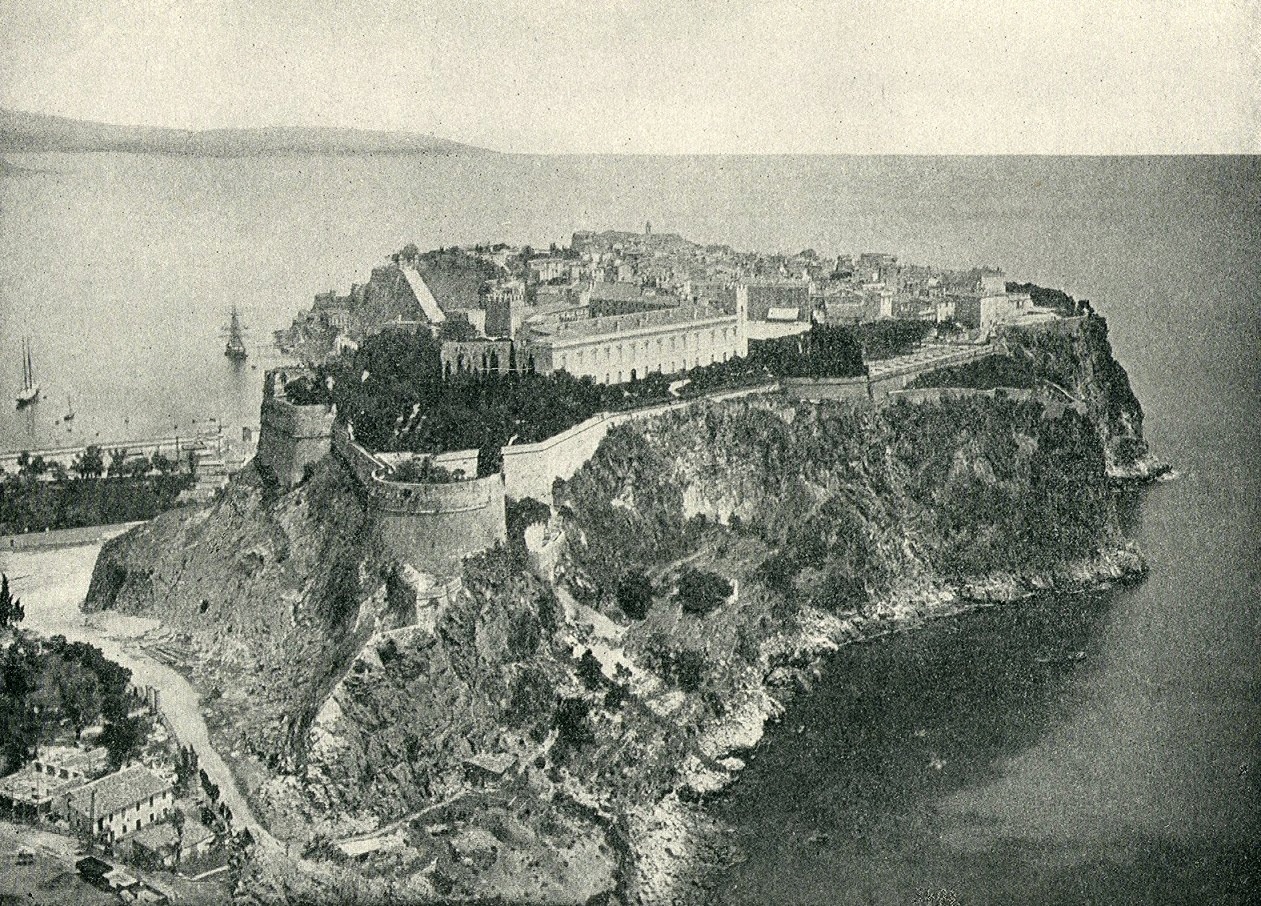
On 8 January 1297, Francesco Grimaldi, a descendant of Otto Canella (consul of Genoa in 1133), took the fortress. With a small army at his disposal, he disguised himself as a Franciscan monk to enter the fortress and then opened the doors to his soldiers. This episode gave rise to his nickname, Malizia (“mischief”). This heroic episode explains the presence of two Franciscans armed with a sword in the coat of arms of Monaco.
How to access the Rocher de Monaco
There are four ways to reach the top of the Rock of Monaco:
- Avenue de la Porte Neuve
- Avenue de la Quarantaine and Fort Antoine from Port Hercule
- The lifts of the Parking des Pêcheurs
- The Rampe Major
The Rampe Major
Access via the Rampe Major is the most direct for pedestrians. This red brick path is undoubtedly the most picturesque access point to the rock, but climbing up is quite arduous.
![Rocher de Monaco - Rampe de la Major © Tiia Monto - licence [CC BY-SA 3.0] from Wikimedia Commons](https://frenchmoments.eu/wp-content/uploads/2014/08/Monaco-Rampe-de-la-Major-©-Tiia-Monto-licence-CC-BY-SA-3.0-from-Wikimedia-Commons-scaled.jpg)
In the past, the walkway was the only means of communication between the Prince’s Palace and the rest of the Principality. The Rampe Major is marked by two gates built in 1533 and 1714, respectively.
After a steep ascent through two hairpins, the Rampe Major leads to the Place du Palais between the Sainte-Marie Tower of the castle and the battery commanding the Condamine.
In 1835-1839, when the progress of artillery had weakened the fortress’s defences, Prince Honoré V decided to build a new road with a constant slope to access the Rock. This is the current Avenue de la Porte Neuve, which runs along the sides of the Rock from the Port Hercule side to the southern point above Fort Antoine.
Places to see in the Rocher de Monaco
All visits to the Rocher de Monaco should start with the famous square of Place du Palais.
Click here to view the principal landmarks of Le Rocher on Google Maps.
Place du Palais
The Place du Palais is one of the most emblematic places in Monaco, forming a vast esplanade on the western side of the Rock of Monaco, between the Prince’s Palace and the old town. Unsurprisingly, the square is one of the most popular sites for tourists.
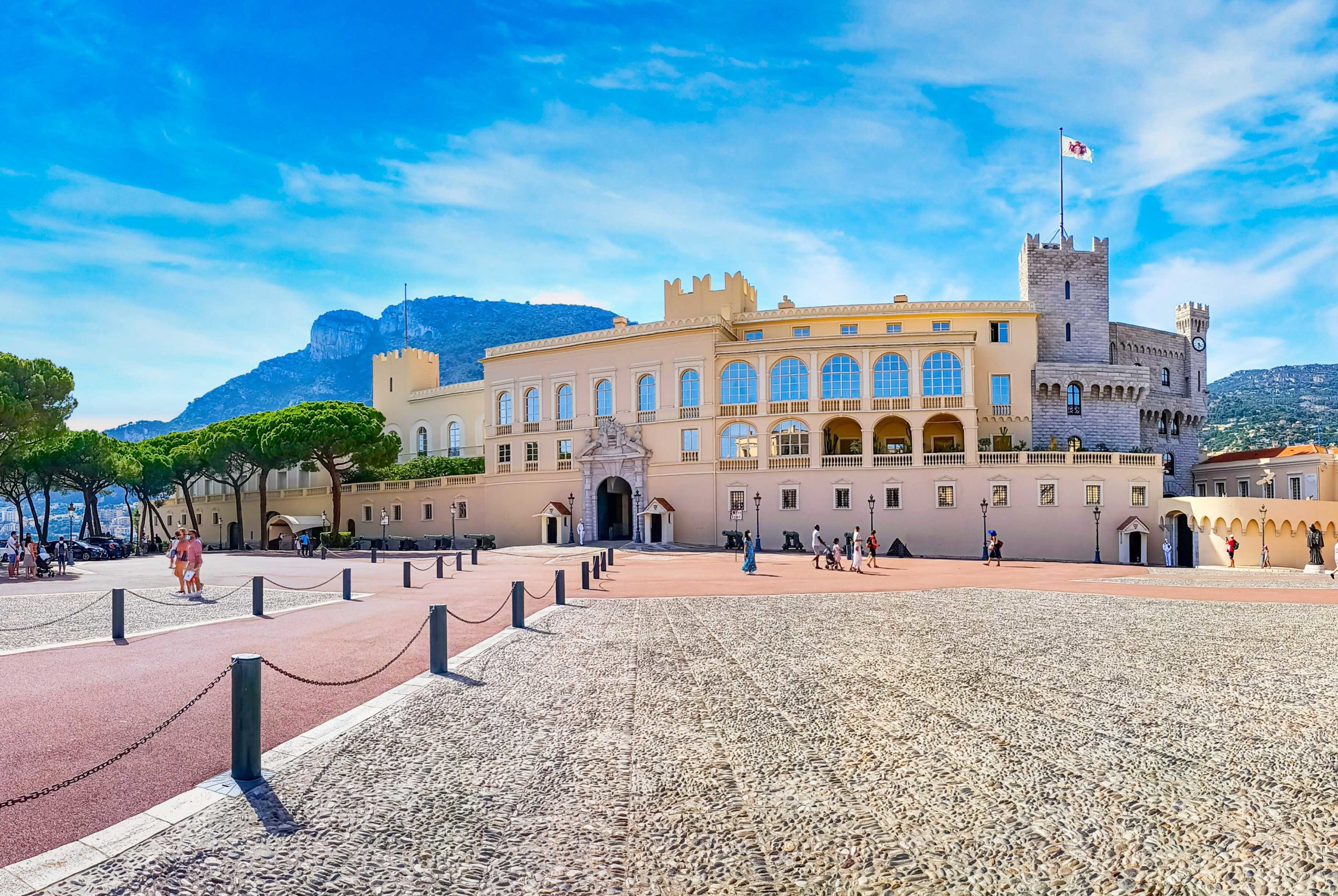
![Rocher de Monaco Place du Palais © kspltj .Polen - licence [CC BY-SA 3.0] from Wikimedia Commons](https://frenchmoments.eu/wp-content/uploads/2014/08/Monaco-Place-du-Palais-©-kspltj-.Polen-licence-CC-BY-SA-3.0-from-Wikimedia-Commons-scaled.jpg)
On either side, it offers magnificent views of the marinas of Port Hercule and Fontvieille.
![Monaco - Port Hercule © S@ndrine - licence [CC BY 2.0] from Wikimedia Commons](https://frenchmoments.eu/wp-content/uploads/2022/09/Monaco-Port-Hercule-©-S@ndrine-licence-CC-BY-2.0-from-Wikimedia-Commons-scaled.jpg)
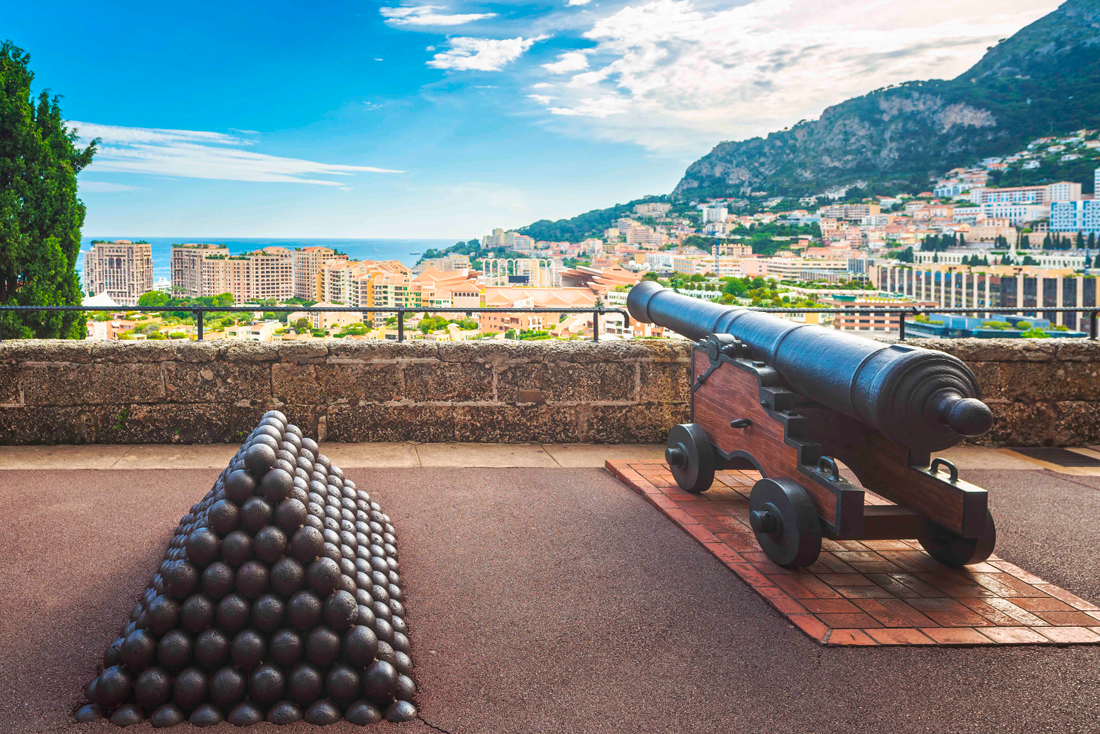
The square is home to the bronze statue of Francesco Grimaldi, which depicts him as a Franciscan monk.
![Francesco Grimaldi © Deuxcentvingtdeux - licence [CC BY-SA 4.0] from Wikimedia Commons](https://frenchmoments.eu/wp-content/uploads/2014/08/Francesco-Grimaldi-©-Deuxcentvingtdeux-licence-CC-BY-SA-4.0-from-Wikimedia-Commons-scaled.jpg)
To the west of the square (overlooking Fontvieille), note the cannons pointed at the sea.
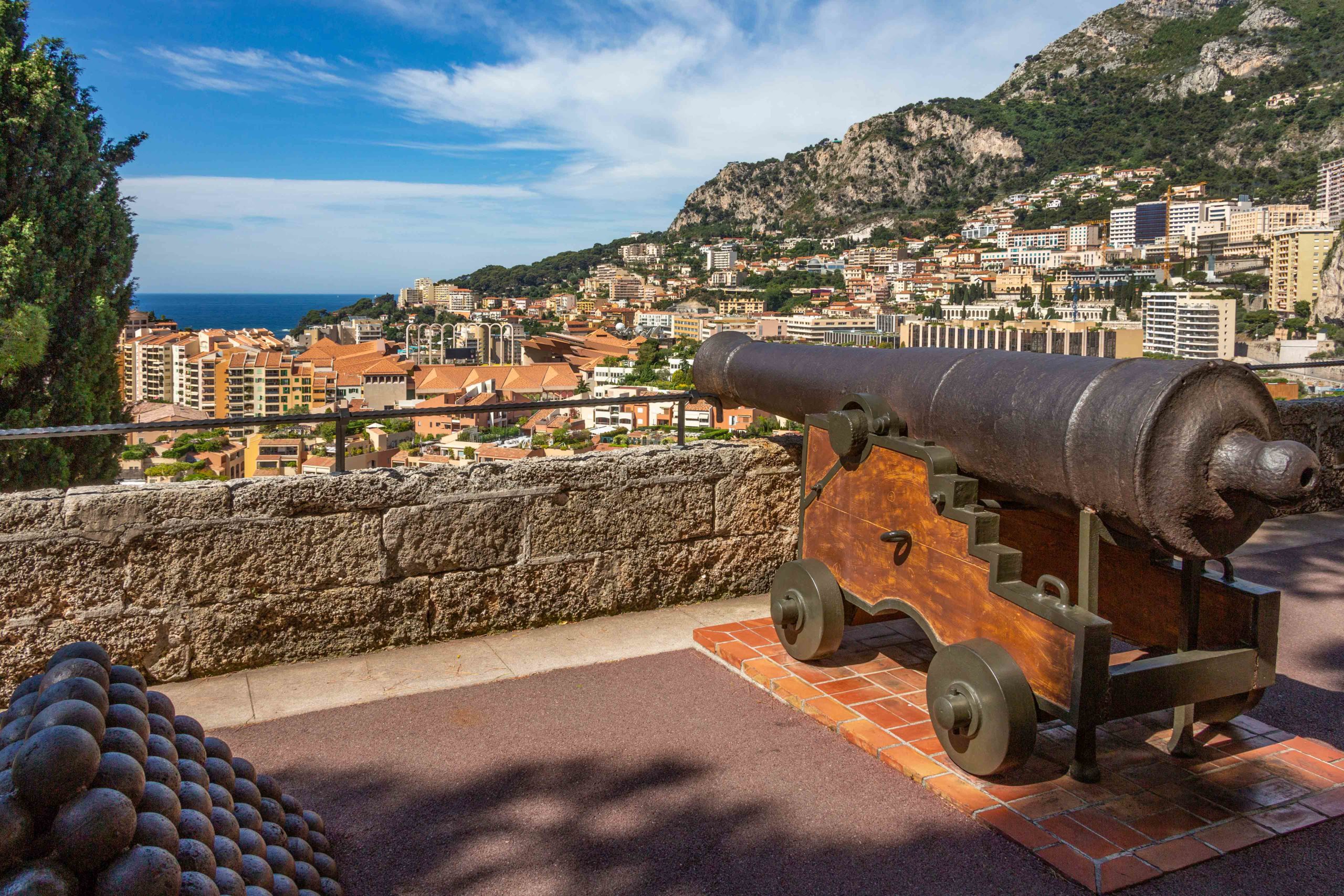
Opposite the palace is the official building of the prince’s guard (the Carabiniers).
![Rocher de Monaco Caserne des Carabiniers © Benoît Prieur - licence [CC0] from Wikimedia Commons](https://frenchmoments.eu/wp-content/uploads/2014/08/Monaco-Caserne-des-Carabiniers-©-Benoît-Prieur-licence-CC0-from-Wikimedia-Commons-scaled.jpg)
The changing of the guard is a very popular event that takes place every day at 11.55 am in the Place du Palais.
![Rocher de Monaco - Changing of the Guards © Nikolai Karaneschev - licence [CC BY 3.0] from Wikimedia Commons](https://frenchmoments.eu/wp-content/uploads/2014/08/Monaco-Changing-of-the-Guards-©-Nikolai-Karaneschev-licence-CC-BY-3.0-from-Wikimedia-Commons.jpg)
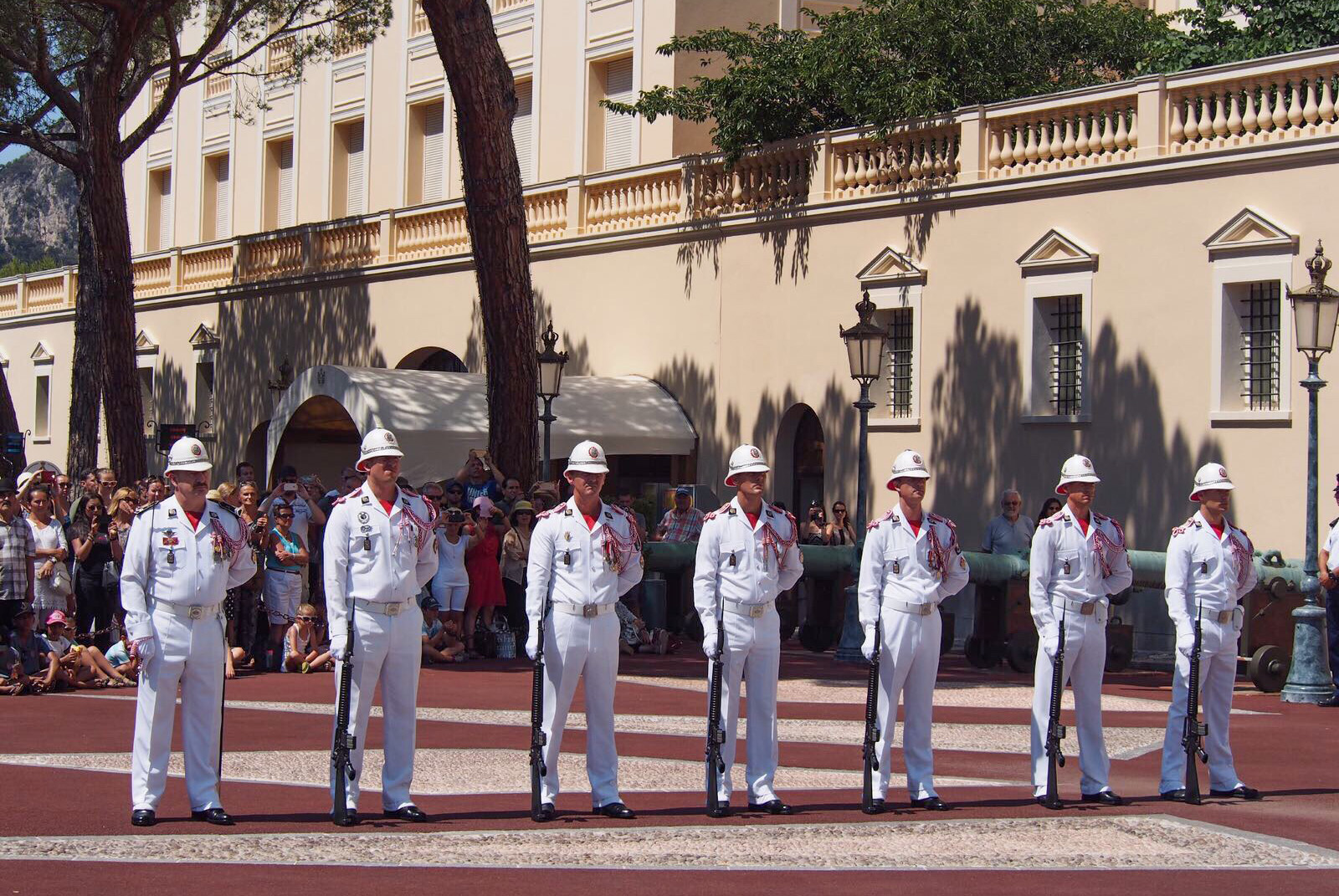
The square is the ideal starting point to discover the old town. Following the narrow streets, you will discover charming little squares and famous Monegasque monuments: the Saint-Nicolas cathedral and the oceanographic museum.
The Prince’s Palace
The Palace of Monaco (Palais princier) has been the official residence of the Prince of Monaco since 1297. It stands on top of the Monaco Rock, the oldest part of the Principality of Monaco, overlooking the Mediterranean Sea by sixty metres.

The castle dates back to 1191, when it initially served as a fortress for the Republic of Genoa. The castle underwent several bombardments and sieges throughout its history. Since the end of the 13th century, it has been the home of the Grimaldi family, who conquered the place in 1297. Therefore, it is the official residence of Prince Albert II.
The splendour of the Palace is open to visitors who can discover:
- the main courtyard and its 17th-century staircase.
- the 17th century “Grands Appartements”, including the Hercules Gallery, the Italian Gallery, the Louis XV Salon, the Mazarin Salon, the Throne Room, the Palatine Chapel and the York Room.
Find out more about the Prince’s Palace of Monaco.
The old town
It’s a real treat to explore the old town, whose old and perfectly maintained houses are reminiscent of the “Renaissance”. During your discovery, you will walk along a maze of old narrow streets lined with shops and businesses.
![Rocher de Monaco from above © Einaz80 - licence [CC BY-SA 4.0] from Wikimedia Commons](https://frenchmoments.eu/wp-content/uploads/2014/08/Monaco-Rock-©-Einaz80-licence-CC-BY-SA-4.0-from-Wikimedia-Commons-scaled.jpg)
The rock of Monaco is crisscrossed by three narrow streets that branch off from the Place du Palais: Rue Basse, Rue Comte Félix Gastaldi and Rue Emile de Loth.
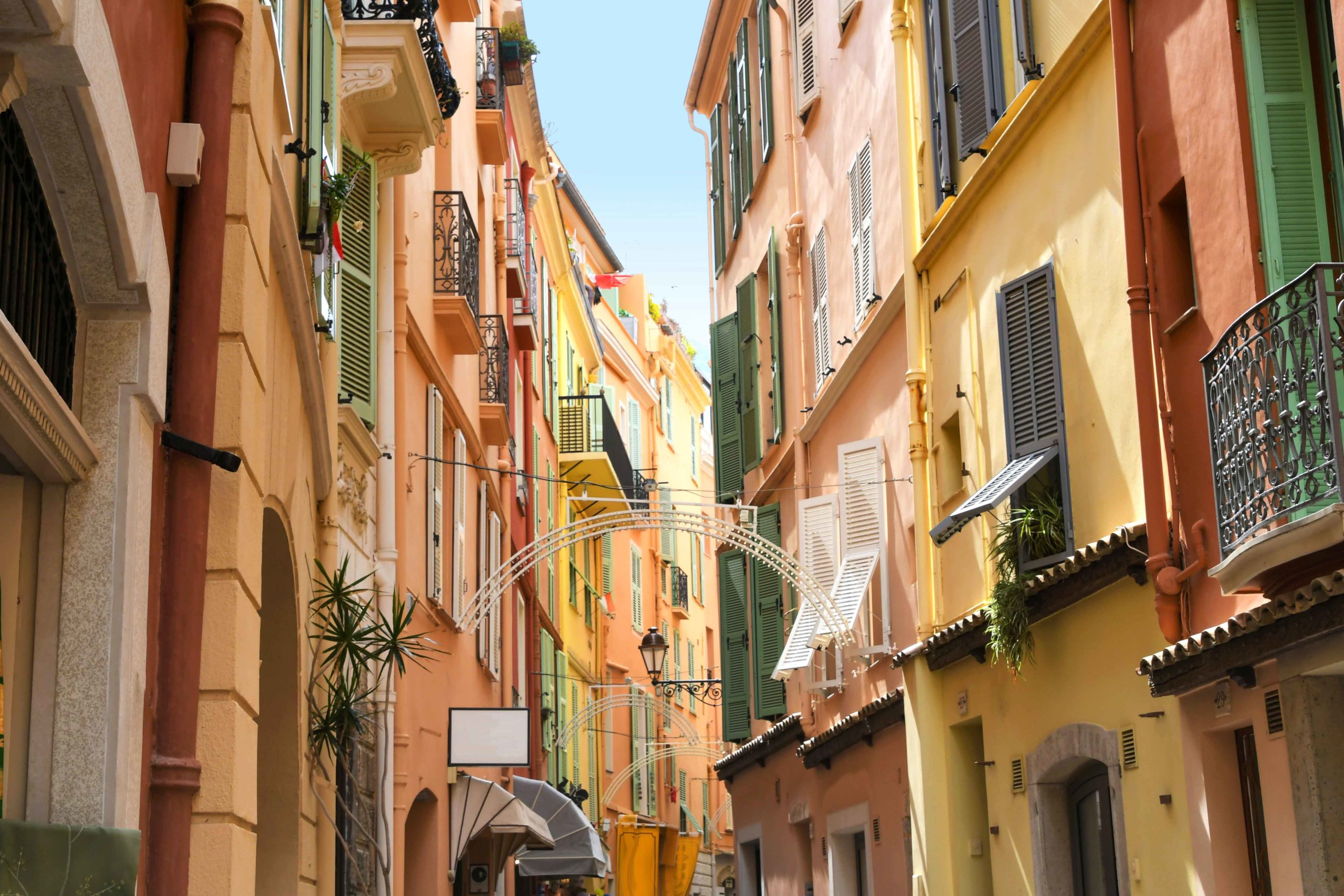
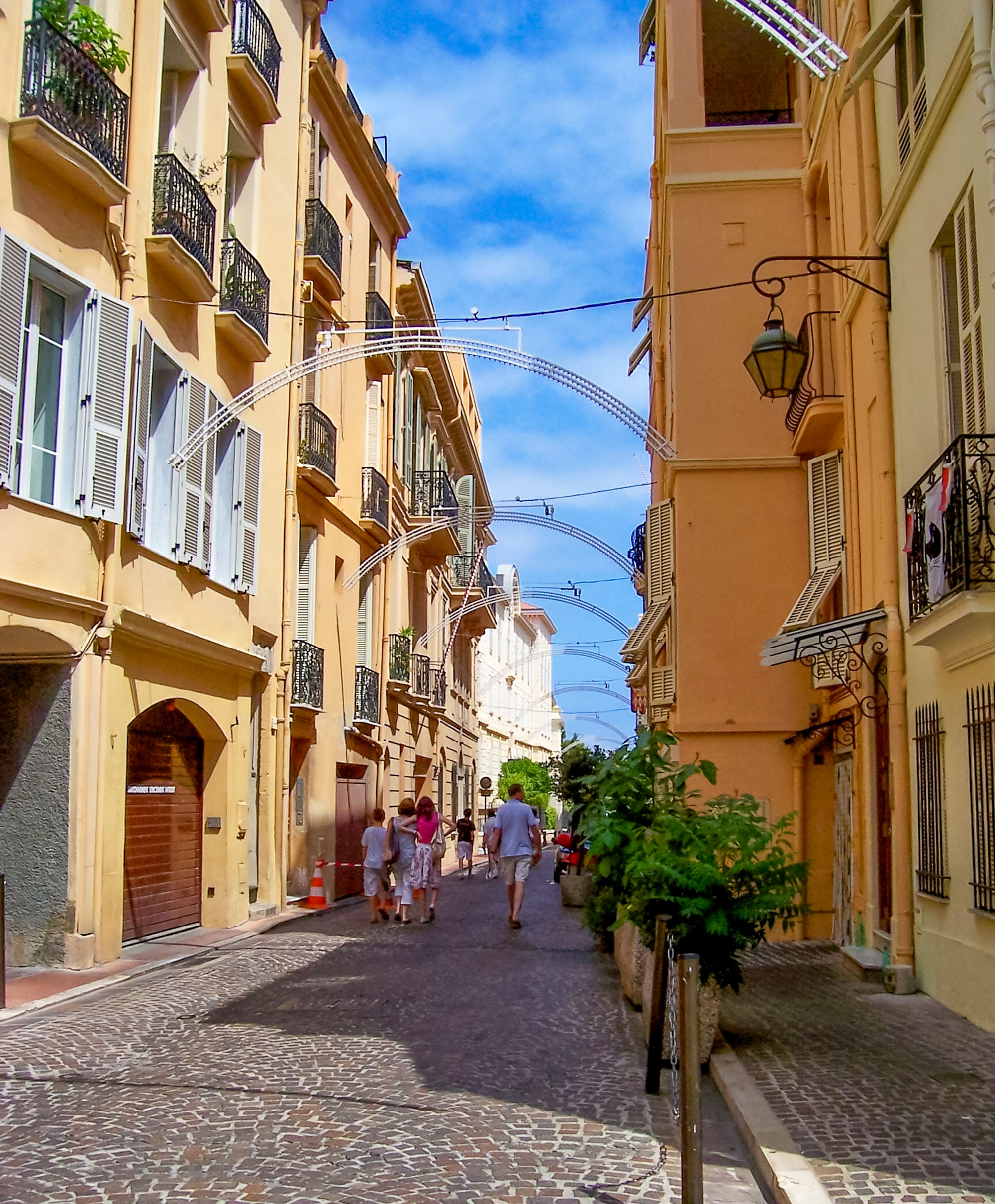
Another street, the Rue du Colonel Bellando de Castro, runs south to serve the cathedral square before becoming the Avenue Saint-Martin which runs to the oceanographic museum.
At the end of the Rock of Monaco are the Jardin des Pêcheurs (Fishermen’s Garden) and Fort Antoine I, which guard the entrance to Port Hercule.
You can visit the old town of Monaco onboard a small train or a panoramic mini-bus.
Monaco Cathedral
The Cathedral of Our Lady Immaculate of Monaco is a Romanesque-Byzantine church commissioned under the principate of Charles III.
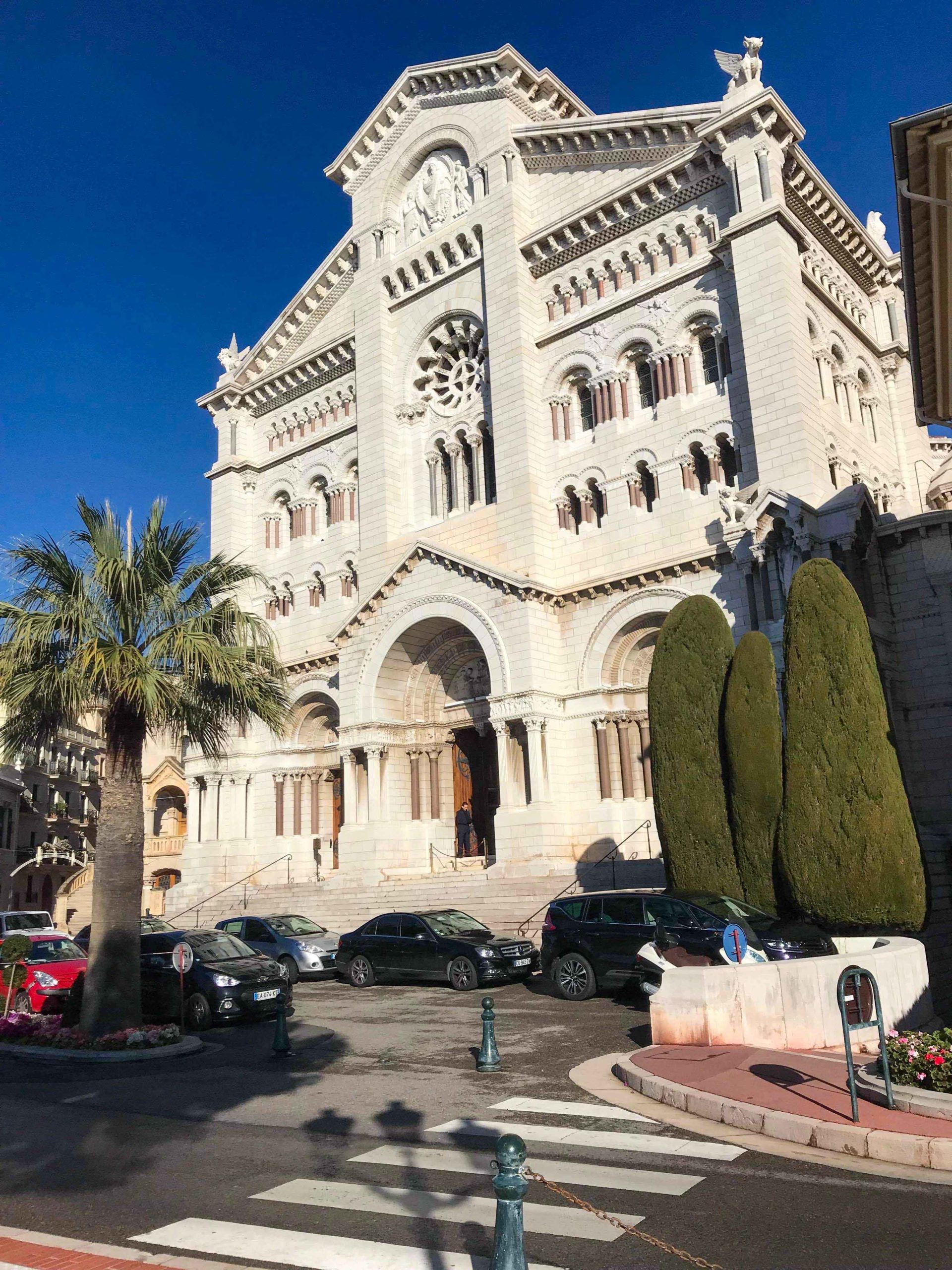
The foundation stone of the present cathedral was laid on 6 January 1875 on the site of the former church of Saint-Nicolas (1252). The completion of the work occurred on 12 November 1903. Its consecration took place in 1911.
The cathedral’s materials are white stone from the nearby village of La Turbie, red and blue porphyry from the Esterel, green and granite from the Vosges, the granite of the choir from Biella and marble from Carrara.
Today, it is the main church of the Monegasque archdiocese.
![Monaco Cathedral - Rocher de Monaco © Rundvald - licence [CC BY-SA 4.0] from Wikimedia Commons](https://frenchmoments.eu/wp-content/uploads/2014/08/Monaco-Cathedral-©-Rundvald-licence-CC-BY-SA-4.0-from-Wikimedia-Commons.jpg)
The cathedral is 72 metres long, 22 metres wide, and 18 metres high.
The interior is worth a visit.
![Monaco Cathedral © jimmyweee - licence [CC BY 2.0] from Wikimedia Commons](https://frenchmoments.eu/wp-content/uploads/2014/08/Monaco-Cathedral-Interior-©-jimmyweee-licence-CC-BY-2.0-from-Wikimedia-Commons.jpg)
![Monaco Cathedral © Pramzan - licence [CC BY-SA 3.0] from Wikimedia Commons](https://frenchmoments.eu/wp-content/uploads/2014/08/Monaco-Cathedral-Interior-©-Pramzan-licence-CC-BY-SA-3.0-from-Wikimedia-Commons.jpg)
Look for the beautiful Saint-Nicolas altarpiece (1500), a work of Louis Bréa, an artist from Nice.
![Monaco Cathedral - Saint Nicolas Altarpiece © Roger Culos - licence [CC BY-SA 4.0] from Wikimedia Commons](https://frenchmoments.eu/wp-content/uploads/2014/08/Monaco-Cathedral-Saint-Nicolas-Altarpiece-©-Roger-Culos-licence-CC-BY-SA-4.0-from-Wikimedia-Commons-scaled.jpg)
The cathedral is famous for containing the tombs of most of the Monaco princes, including Prince Rainier and Princess Grace.
![Tomb of Rainier III in the cathedral of Monaco © Berthold Werner - licence [CC BY-SA 3.0] from Wikimedia Commons](https://frenchmoments.eu/wp-content/uploads/2014/08/Monaco-Cathedral-Tomb-of-Rainier-III-©-Berthold-Werner-licence-CC-BY-SA-3.0-from-Wikimedia-Commons-scaled.jpg)
The sanctuary was built in Romanesque-Byzantine style between 1875 and 1903 on the site of a former parish church dedicated to St Nicholas.
Oceanographic Museum of Monaco
The Oceanographic Museum of Monaco is a neo-baroque oceanographic museum-aquarium built into the cliffside on the Rock of Monaco.
![Monaco Oceanographic Museum - Rocher de Monaco © Mister No - licence [CC BY 3.0] from Wikimedia Commons](https://frenchmoments.eu/wp-content/uploads/2014/08/Monaco-Oceanographic-Museum-01-©-Mister-No-licence-CC-BY-3.0-from-Wikimedia-Commons-scaled.jpg)
Prince Albert I of Monaco founded the museum in 1889, facing the Mediterranean Sea. The building was inaugurated in 1910. Its aquariums house over 6,000 marine specimens, including eerie sharks, delicate leafy sea dragons, angler fish, star fish, turtles, jellyfish, crabs, lobsters, rays, eels, and strange and colourful sea creatures.
![Monaco Oceanographic Museum © Mister No - licence [CC BY 3.0] from Wikimedia Commons](https://frenchmoments.eu/wp-content/uploads/2014/08/Monaco-Oceanographic-Museum-02-©-Mister-No-licence-CC-BY-3.0-from-Wikimedia-Commons-scaled.jpg)
![Monaco Oceanographic Museum © Harakis_picture - licence [CC BY-SA 4.0] from Wikimedia Commons](https://frenchmoments.eu/wp-content/uploads/2014/08/Monaco-Oceanographic-Museum-©-Harakis_picture-licence-CC-BY-SA-4.0-from-Wikimedia-Commons-scaled.jpg)
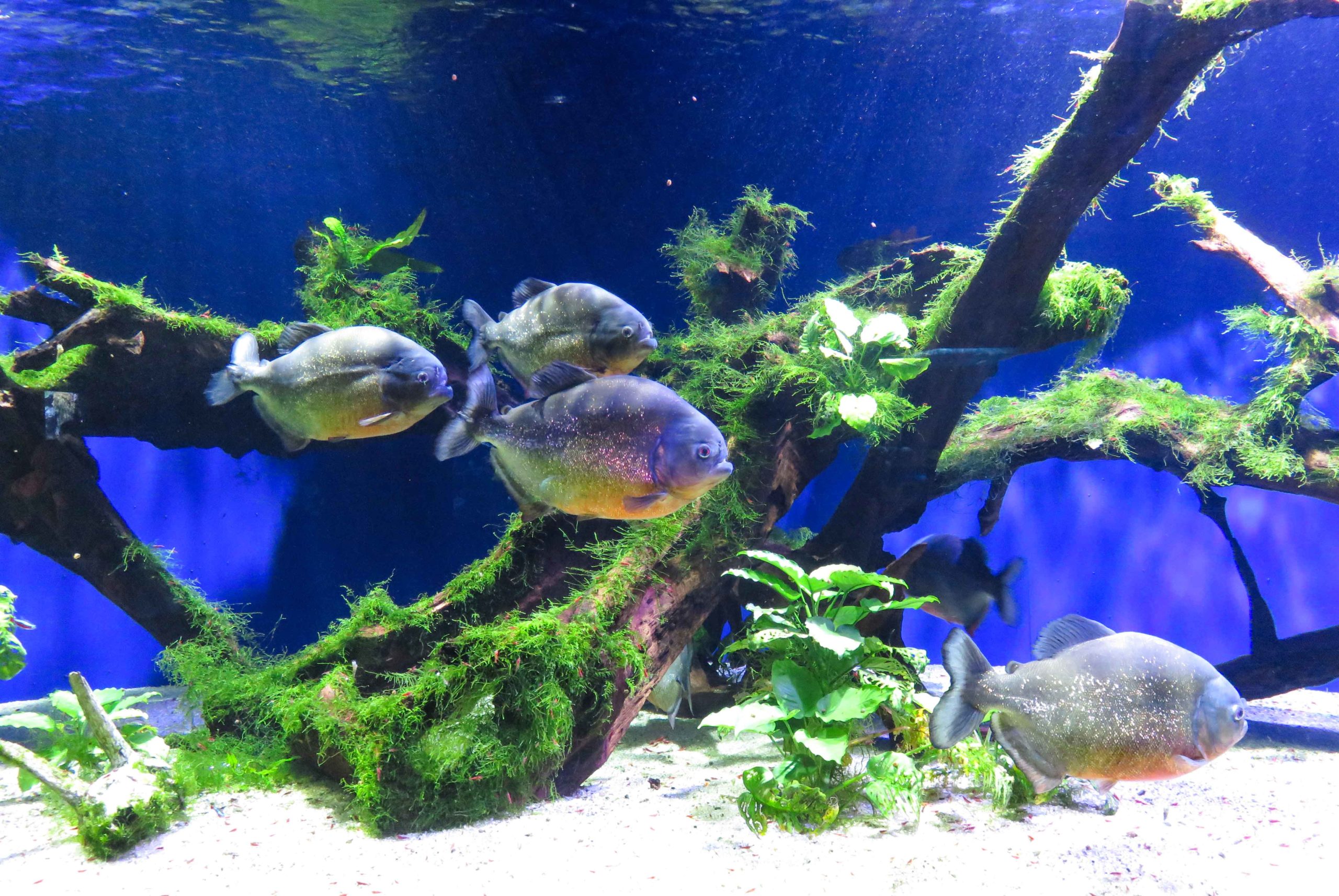
![Monaco Oceanographic Museum, Shark Lagoon © M. Dagnino - licence [CC BY-SA 3.0] from Wikimedia Commons](https://frenchmoments.eu/wp-content/uploads/2014/08/Monaco-Oceanographic-Museu-Shark-Lagoon-©-M.-Dagnino-licence-CC-BY-SA-3.0-from-Wikimedia-Commons.jpg)
The museum and its Oceanographic Institute were directed by famous underwater explorer Captain Jacques-Yves Cousteau from 1957 to 1988. Some of his films are projected in the conference hall of the aquarium. The building is also home to the Mediterranean Science Commission.
The rooftop terrace offers some fantastic views over Monaco and its surroundings.
👉 Get your entry ticket to the Oceanographic Museum here…
![Monaco Oceanographic Museum - Rocher de Monaco © Edgar EI - licence [CC BY 3.0] from Wikimedia Commons](https://frenchmoments.eu/wp-content/uploads/2014/08/Monaco-Oceanographic-Museum-©-Edgar-EI-licence-CC-BY-3.0-from-Wikimedia-Commons-scaled.jpg)
Palace of Justice
The Palace of Justice (Courthouse) was built at the beginning of 1924 on the initiative of Prince Louis II and inaugurated on 1 May 1930.
![Palace of Justice - Rocher de Monaco © Niels Mickers - licence [CC BY-SA 3.0 nl] from Wikimedia Commons](https://frenchmoments.eu/wp-content/uploads/2014/08/Monaco-Justice-Palace-©-Niels-Mickers-licence-CC-BY-SA-3.0-nl-from-Wikimedia-Commons-scaled.jpg)
For its construction, the architects used marine tuff, a grey and porous stone of which the ramparts of Monaco are made. This stone includes many small pebbles and sometimes mollusc shells.
The façade of the court is of Italianate Gothic inspiration. The symmetrical double staircase is reminiscent of the courtyard of honour of the Prince’s Palace.
Look for the old bust of Prince Honoré II, dating from 1568, on the façade of the Palace.
The Palace of Justice is not open to visitors.
Fontaine Saint-Nicolas
Between the Palace of Justice and the cathedral, you have to go up the rue de l’église to reach the fountain of Saint-Nicolas. In the centre of this pleasant little square is a pretty fountain topped by a statue of Saint Nicholas.
![Rocher de Monaco - fontaine Saint Nicolas © Benoît Prieur - licence [CC0] from Wikimedia Commons](https://frenchmoments.eu/wp-content/uploads/2014/08/Monaco-Place-Saint-Nicolas-©-Benoît-Prieur-licence-CC0-from-Wikimedia-Commons-scaled.jpg)
Several residential buildings with elegant balconies surround the square. There are restaurants and boutiques.
Chapelle de la Miséricorde
The Chapel of the Miséricorde is located in the square of Place de la Mairie. It is a baroque-style Catholic shrine.

The chapel was founded for the Confrérie des Pénitents Noirs aka de la Miséricorde. The first stone was laid on 13 June 1639, and the inauguration took place on 28 January 1646 in the presence of the Bishop of Nice.
Rue Sainte-Barbe
The delightful Rue Sainte-Barbe is often overlooked by tourists visiting the Rock of Monaco. In fact, they are unaware of its existence. It is a pedestrian alley with no cars, shops or restaurants.
![Rocher de Monaco Ruelle Sainte-Barbe © Tiia Monto - licence [CC BY-SA 3.0] from Wikimedia Commons](https://frenchmoments.eu/wp-content/uploads/2014/08/Monaco-Ruelle-Sainte-Barbe-©-Tiia-Monto-licence-CC-BY-SA-3.0-from-Wikimedia-Commons-scaled.jpg)
The alley winds along the southeastern ridge of the Rock, between the Prince’s Palace and the Saint Martin Gardens. It offers a plunging view of the Fontvieille marina. Halfway along the path is a brick watchtower, a relic of Monaco’s fortified past.
The Saint Martin Gardens
The Jardins Saint-Martin was the first public garden to be opened in the Principality in 1816. At that time, famine struck the Principality and to provide work for the inhabitants, the park was built on an abandoned plot of land.
![Jardins Saint-Martin © Katonams - licence [CC BY-SA 4.0] from Wikimedia Commons](https://frenchmoments.eu/wp-content/uploads/2014/08/Monaco-Jardins-Saint-Martin-©-Katonams-licence-CC-BY-SA-4.0-from-Wikimedia-Commons.jpg)
Initially, the Saint-Martin gardens were a typical Mediterranean garden with pine trees, holm oaks, olive trees, fig trees and cypresses. Other exotic species acclimatised to the site have since been added.
You will find the Saint-Martin gardens down the Avenue Saint-Martin, between the Oceanographic Museum and the Cathedral.
Along the steep, winding paths that follow the slope of the Rock, walkers enjoy exceptional views of the Mediterranean Sea.
![Jardins Saint-Martin © Arnaud 25 - licence [CC BY-SA 4.0] from Wikimedia Commons](https://frenchmoments.eu/wp-content/uploads/2014/08/Monaco-Jardins-Saint-Martin-©-Arnaud-25-licence-CC-BY-SA-4.0-from-Wikimedia-Commons.jpg)
On a promontory facing the Mediterranean stands a bronze statue of Prince Albert I, nicknamed “The Navigator Prince”.
![Jardins Saint-Martin Albert 1er © kajikawa - licence [CC BY 3.0] from Wikimedia Commons](https://frenchmoments.eu/wp-content/uploads/2014/08/Monaco-Jardins-Saint-Martin-Albert-1er-©-kajikawa-licence-CC-BY-3.0-from-Wikimedia-Commons.jpg)
Chapelle de la Visitation
Opposite the building of the “Ministère d’Etat”, the Baroque-style Chapel of the Visitation dates from 1675 on the orders of Charlotte de Gramont, wife of Prince Louis I.
![Rocher de Monaco - Chapelle de la Visitation © Aimelaime - licence [CC BY-SA 4.0] from Wikimedia Commons](https://frenchmoments.eu/wp-content/uploads/2014/08/Monaco-Chapelle-de-la-Visitation-©-Aimelaime-licence-CC-BY-SA-4.0-from-Wikimedia-Commons-scaled.jpg)
It was the chapel of the Visitandine convent, founded by the Princess and intended to educate young girls from the Monegasque community and the surrounding area.
Fort Antoine
Fort Antoine is an early 18th-century fortress on the eastern tip of the Rock with a breathtaking view of the Mediterranean.
![Rocher de Monaco Fort Saint-Antoine © Андрей Бобровский - licence [CC BY 3.0] from Wikimedia Commons](https://frenchmoments.eu/wp-content/uploads/2014/08/Monaco-Fort-Saint-Antoine-©-Андрей-Бобровский-licence-CC-BY-3.0-from-Wikimedia-Commons-scaled.jpg)
The Prince of Monaco built it during the Spanish War of Succession (1700-1715). Antoine I feared that the British or the Spanish would invade Monaco. However, this never happened, and the fort was abandoned soon after.
During the French Revolution, the revolutionaries who occupied Monaco garrisoned the fortress until the fall of Napoleon in 1815. Once again, Fort Antoine was abandoned during the 19th century and became a ruin.
In 1942, the Italians occupied Monaco, followed by the Germans a year later. Both garrisoned Fort Antoine during the war and even built tunnels beneath it.
The bombings of the Allies destroyed the fort in July 1944, and Prince Rainier III rebuilt it in 1953 as part of a drive to revive the tourism industry.
The site has become a place for walking and houses an open-air theatre.
Access is free outside events.
Pin it for later!
Did you enjoy reading about the Rock of Monaco? If so, please share this article on Facebook or Twitter, or pin this image on Pinterest!
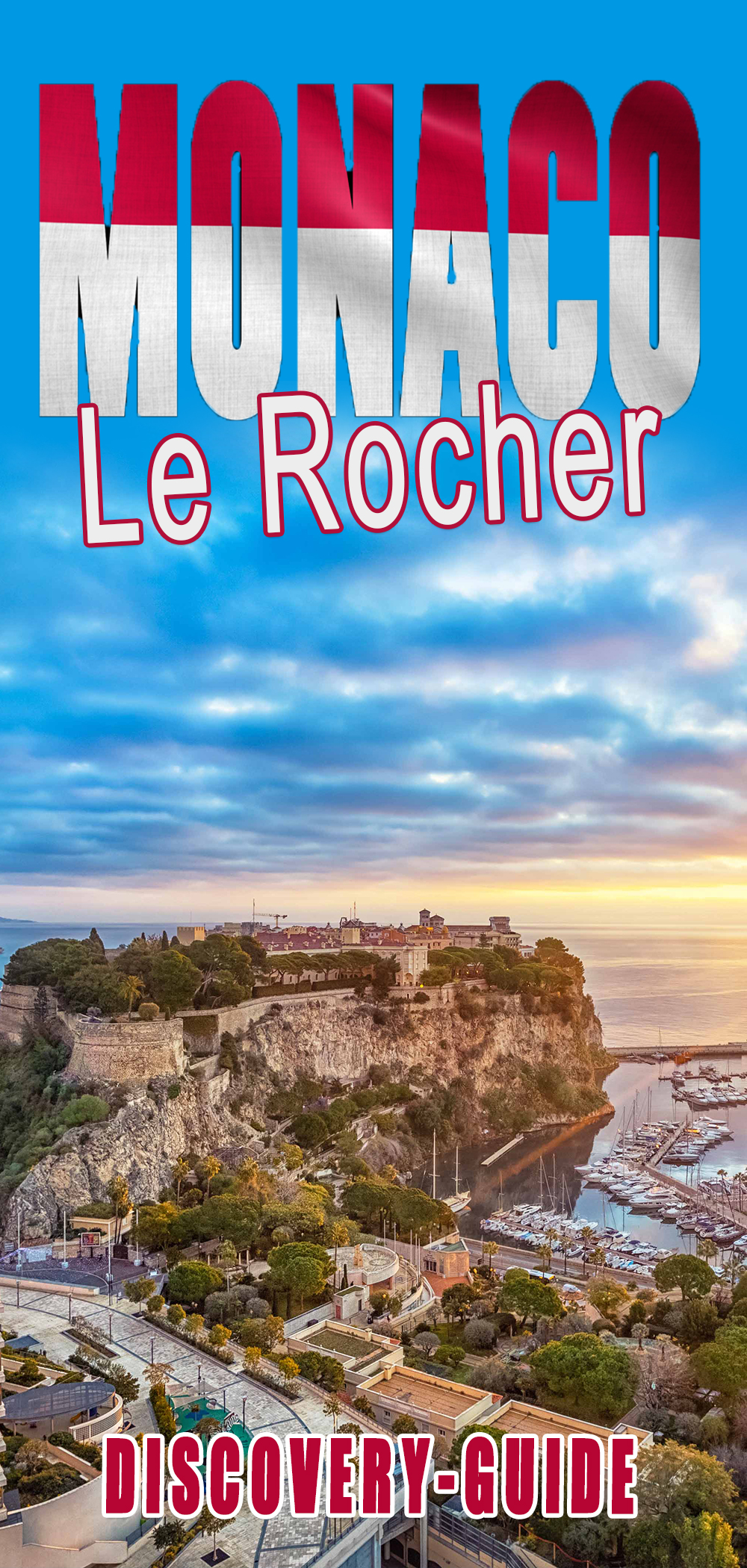
More info about the Rock of Monaco
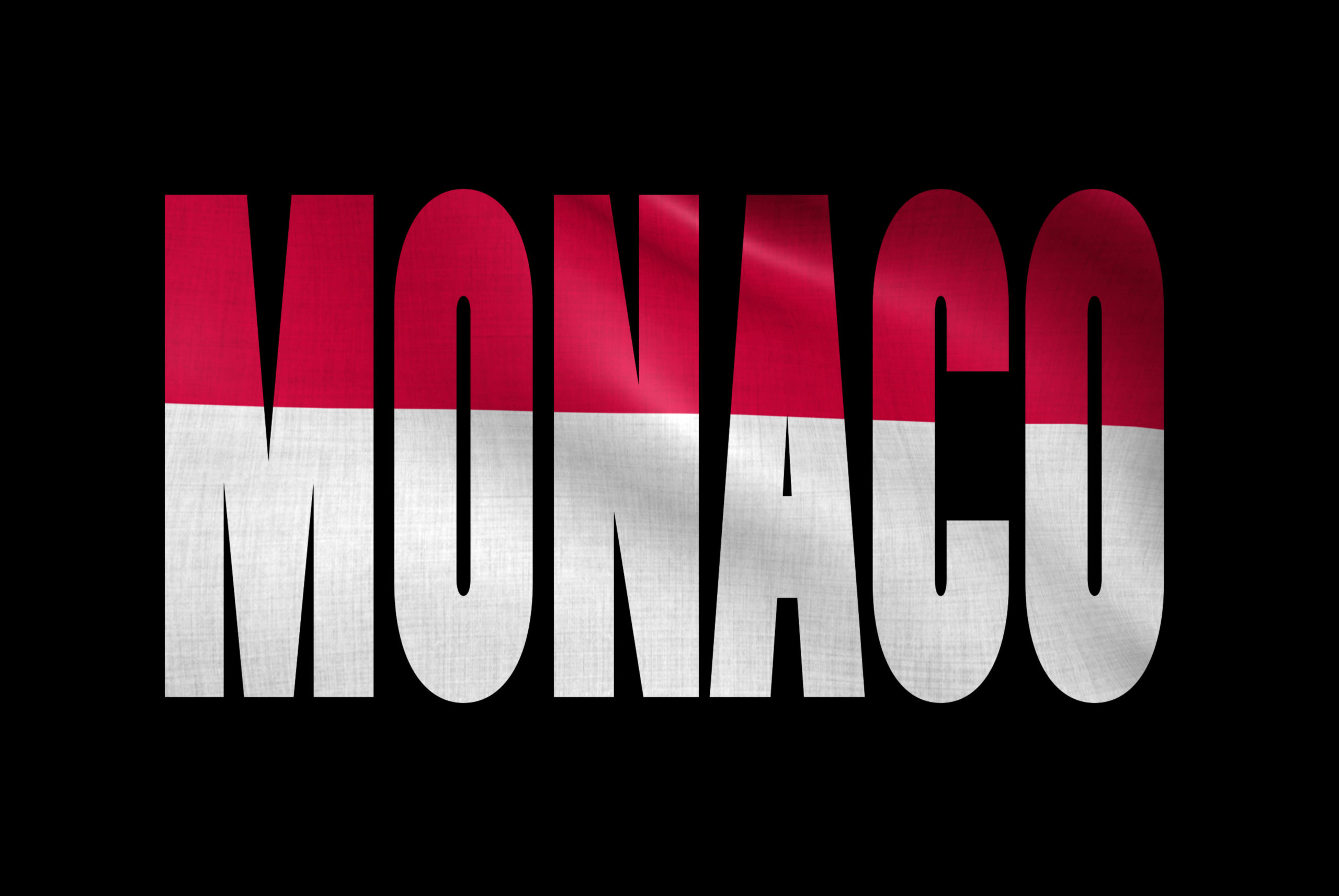
What to do in Monaco?
Want to know what you can do in and around Monaco? Click on the image below for a list of activities:
From Private Guided Walking Tour to Lamborghini Driving Experience and French Riviera Cruises, the Principality dazzles with glamorous activities you won’t forget. Here’s a little list of what’s on offer!
Where to stay in Monaco?
Did you know? There are 12 hotels in the Principality, four ***** and four ****. Unsurprisingly, accommodation in the Principality is very expensive. Unless you absolutely want to stay within the Principality, there is a cheaper alternative. For this, you should look at the Beausoleil district in France, a few minutes walk from the Monaco train station. Prices are much more affordable than in Monaco.
Click here to choose your accommodation in Monaco and its surroundings, or browse the map below:
How to get to the Principality of Monaco
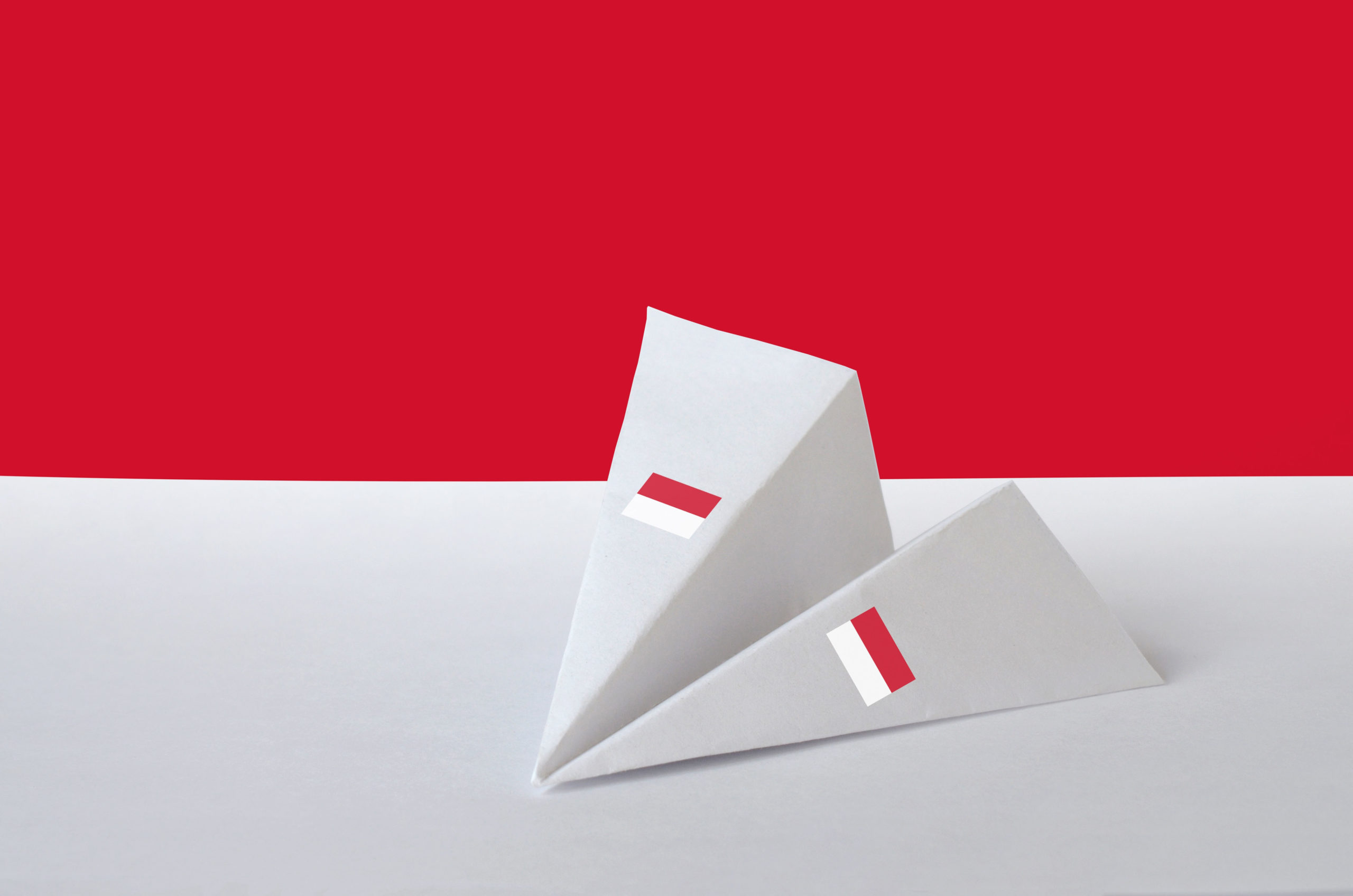
Arriving by car
Monaco is accessible from Nice via the scenic coastal Corniche roads:
- the Corniche Inférieure road follows the coast via Beaulieu,
- the Moyenne Corniche passes through Èze,
- and the Grande Corniche crosses La Turbie.
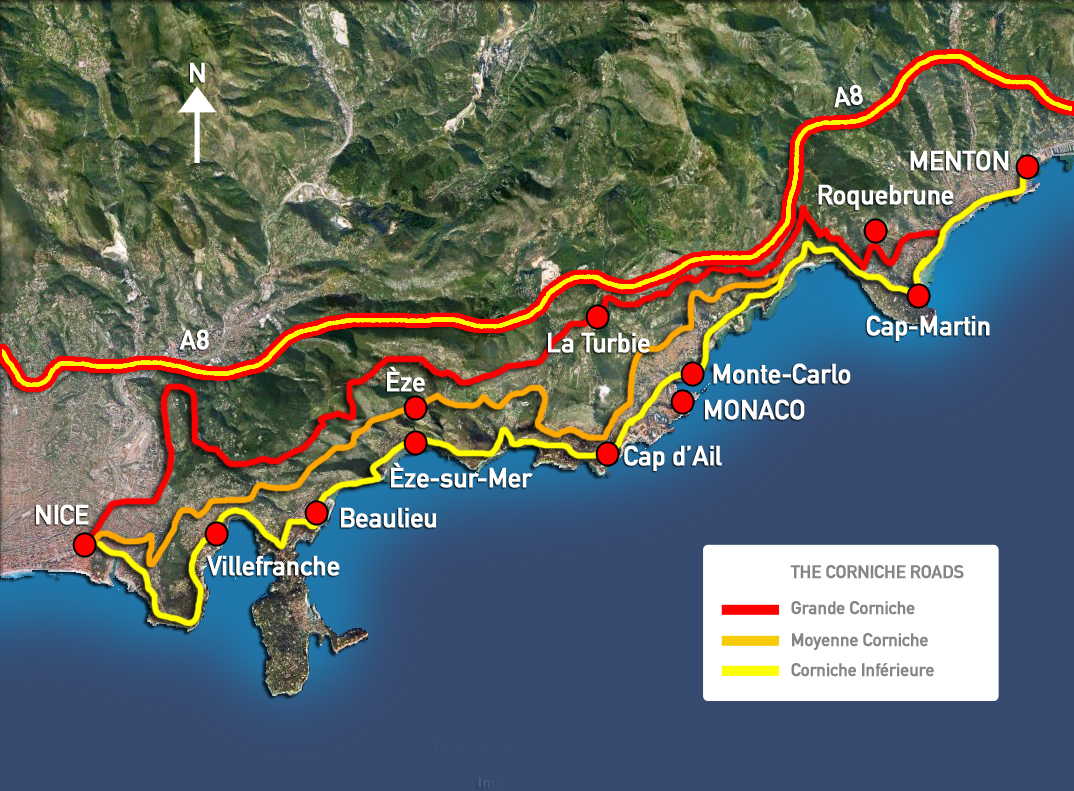
The Principality is bordered by the French A8 motorway linking Provence to Italy. Paris is 950 km away via the A6, A7 and A8 motorways.
Thanks to the A8 motorway, you can reach the centre of Monaco in less than 30 minutes from Nice and its airport.
- Exit 56 “Monaco” in the direction of France -> Italy
- Exit 58 “Roquebrune Cap Martin” in the direction of Italy -> France
However, please note that access to Monaco-Ville (Le Rocher) is limited to users whose vehicle is registered in Monaco and the French département of Alpes Maritimes [06].
How to park in Monaco
Other vehicles should park in the Parking des Pêcheurs, which has pedestrian access to the Rock in a few minutes.
It is advisable to leave your vehicle in one of the many public car parks. The Principality has no less than 40 car parks with 15,500 spaces.
All the car parks are underground, guarded and secure. They are therefore the best solution for parking your vehicle. All public “Monaco Parking” offers free parking for 1 hour. For more information, visit the official website of the Monaco Carparks.
Nearest Airport
Nice-Côte d’Azur International Airport links the Principality of Monaco to more than 86 destinations worldwide.
Through Nice Airport (25 minutes away by motorway), Monaco is linked daily to the main European capitals and, beyond, to all continents.
The airline Air France offers 73 flights a day to Nice Airport, directly from 15 cities in France and seven cities worldwide.
Moreover, the airport is 7 km away by helicopter to the Monaco heliport situated in the Fontvieille district.
Monaco Train Station
Monaco is located on the Marseille-Ventimiglia railway line. The underground SNCF station at Monaco-Monte-Carlo, offers daily TGV services to Paris, and up to ten other cities, via the nearby Nice-Ville station.
TER trains link Monaco to Menton and Ventimiglia to the north-east, Nice, Antibes, Cannes, Grasse and Saint-Raphaël to the south-west.
In addition, there are several daily connections to Turin, Milan and Rome via Ventimiglia.
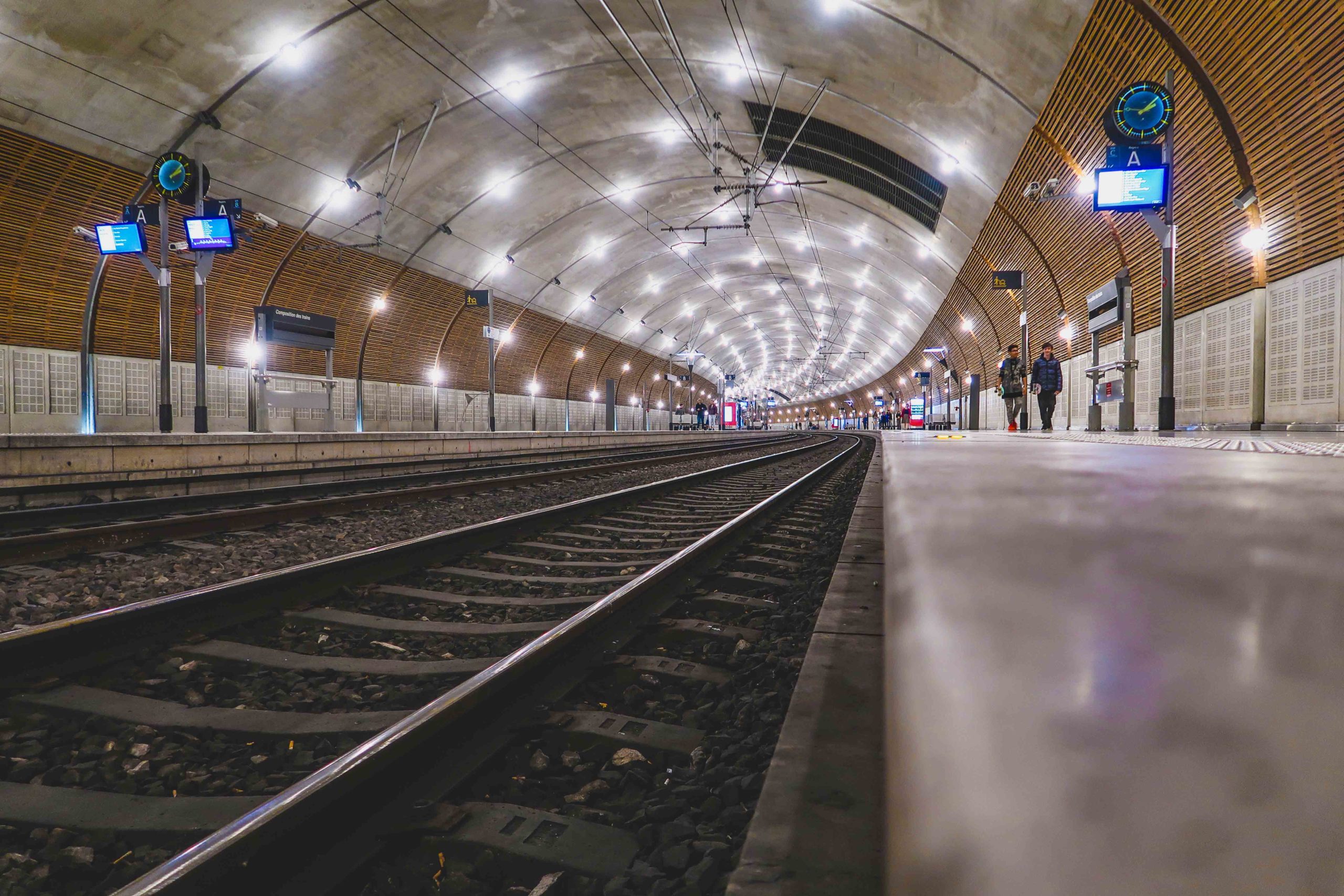
Six entrances allow users to access the underground railway station via a series of escalators or lifts:
Sainte Dévote Bridge, Parvis de la Gare (behind Sainte Dévote Church), Port Hercule, Jardin Exotique, Allée Lazare Sauvaigo/Rue Grimaldi/Rue Suffren-Reymond, Avenue Prince Pierre.
English-French Vocabulary
(f) for féminin, (m) for masculin, (adj) for adjective and (v) for verbs
- Alps = Alpes (f,p)
- aquarium = aquarium (m)
- cathedral = cathédrale (f)
- castle = château (m)
- court house = palais de justice (m)
- French Riviera = Côte d’Azur (f)
- harbour = port (m)
- marina = port de plaisance (m)
- Maritime Alps = Alpes Maritimes (f,p)
- Mediterranean Sea = Mer Méditerranée (f)
- micro-state = micro-état (m)
- museum = musée (m)
- old town = vieille-ville (f)
- palace = palais (m)
- Prince = Prince (m)
- Principality = Principauté (f)
- port = port (m)
- rock = rocher (m)
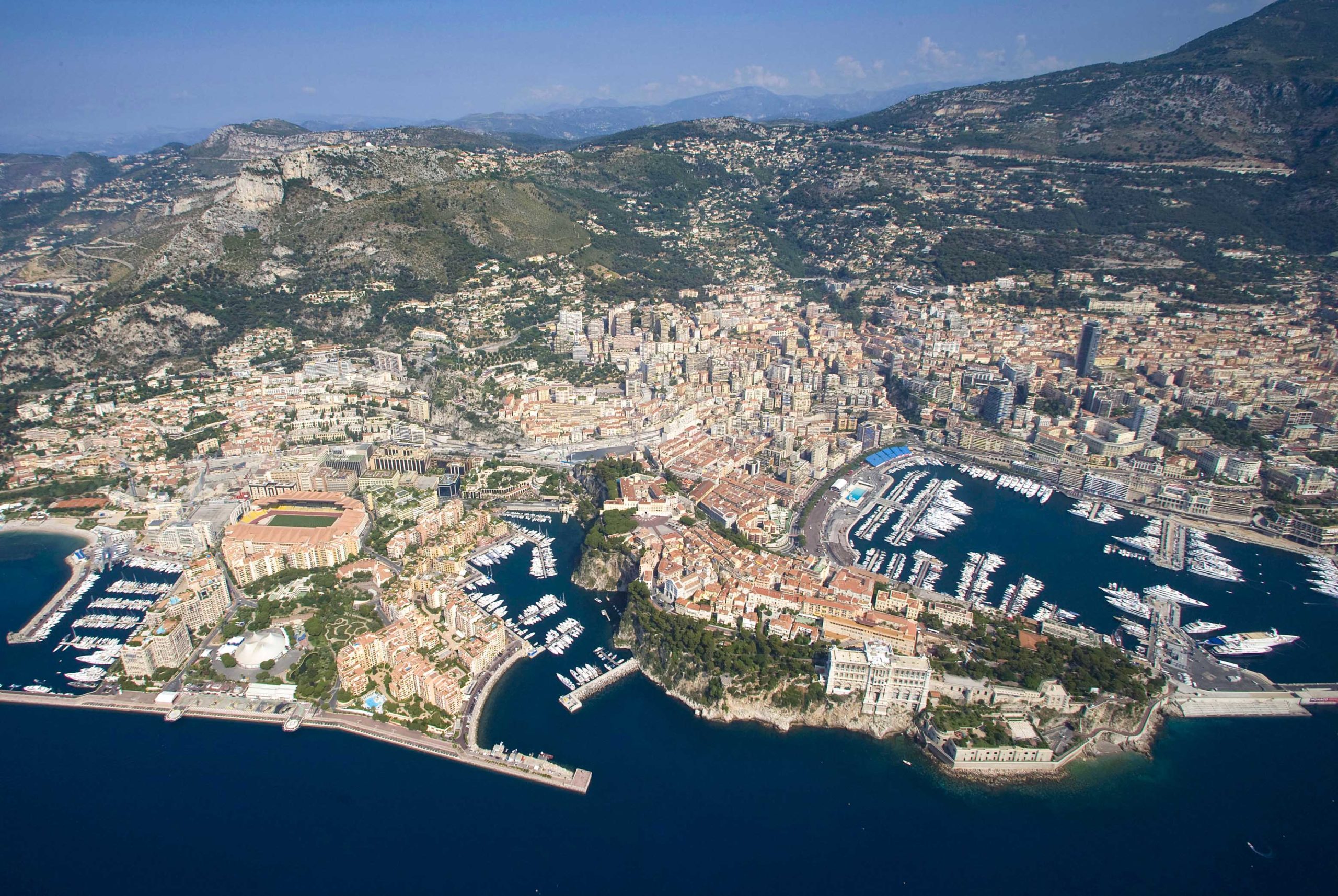
Featured image: The Rock of Monaco (Le Rocher de Monaco). Photo: bbsferrari via Envato Elements

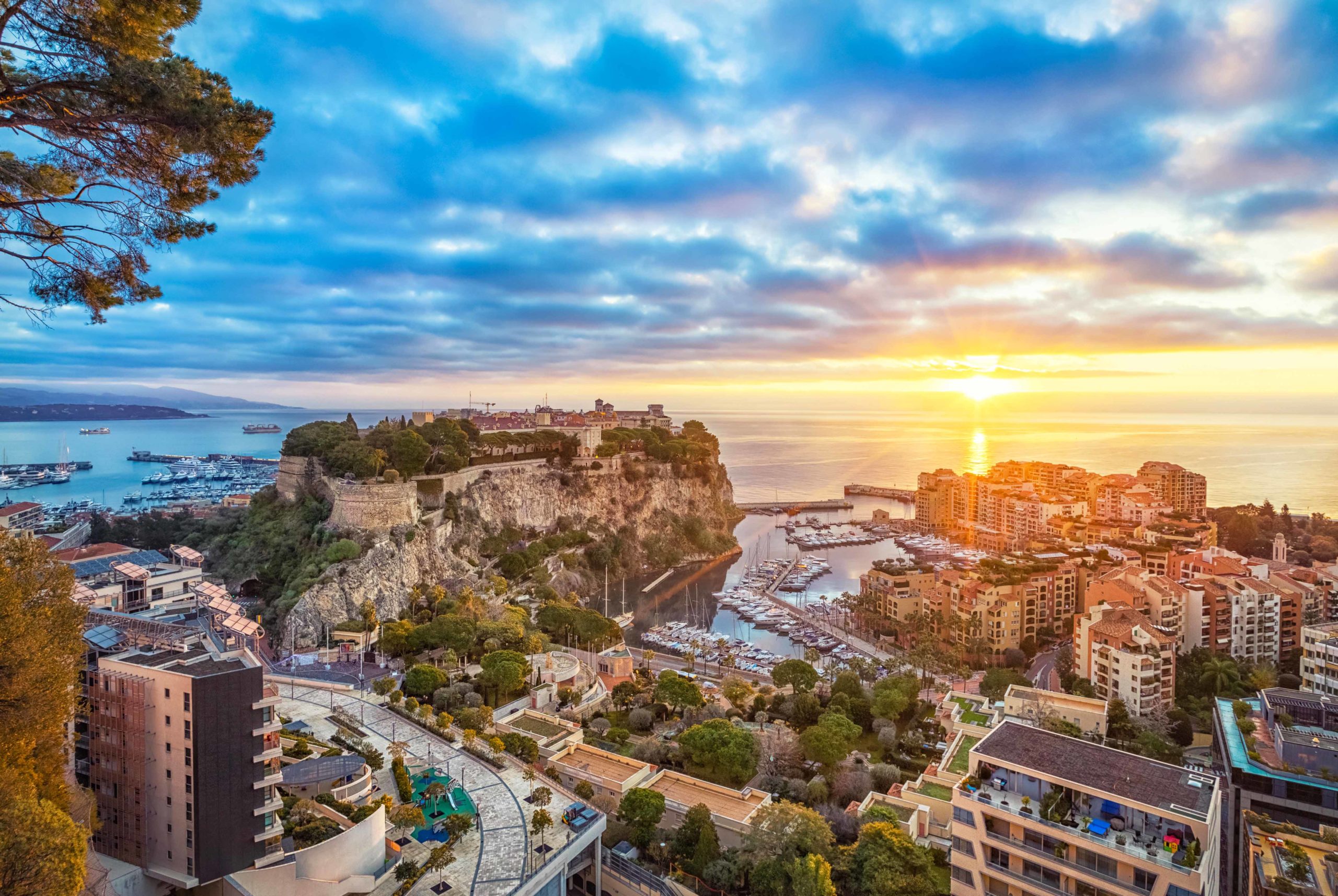

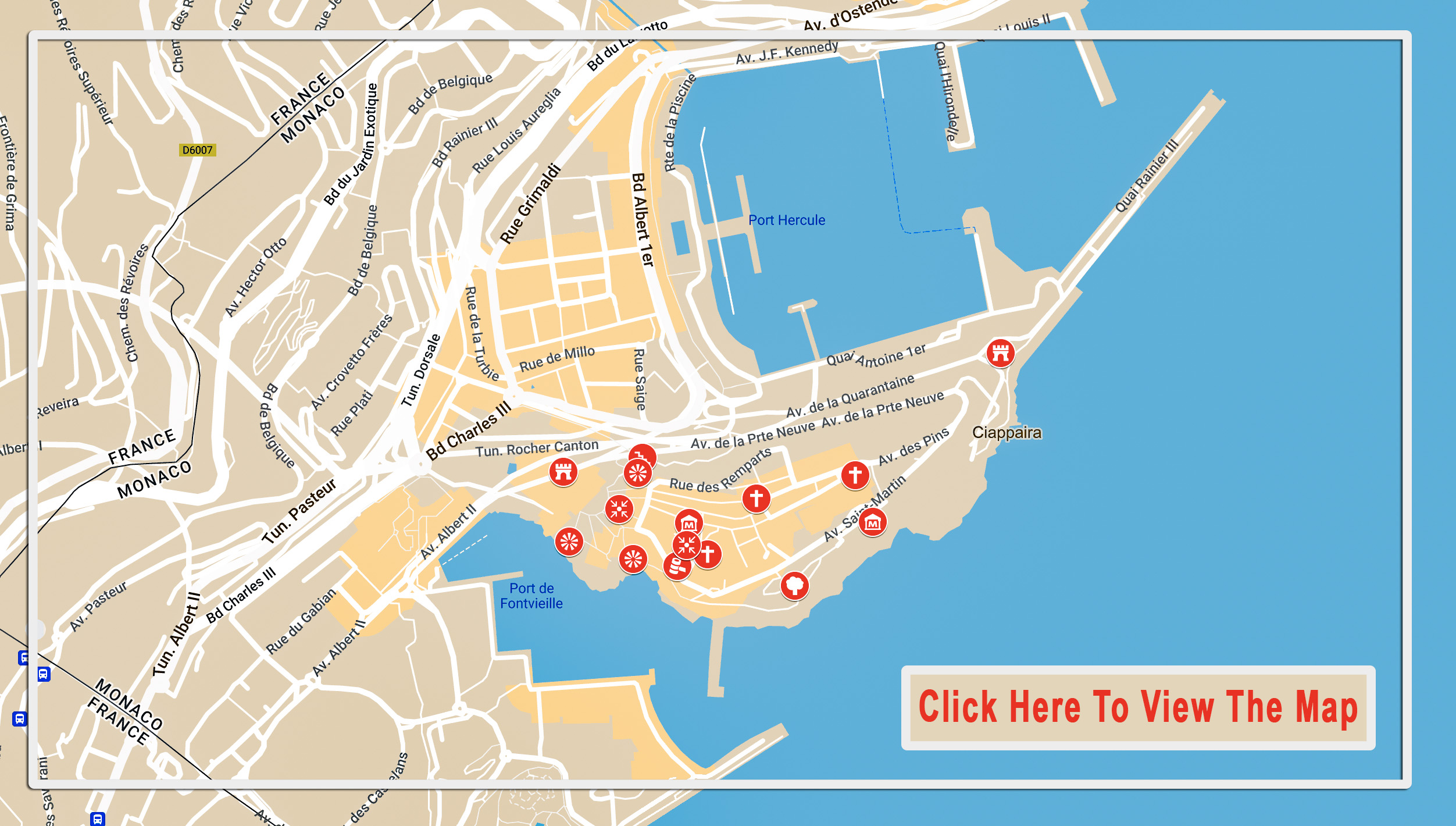


very usefull information, as our cruise ship will anchorage in Monacco. as a crew member we have only around 2 hour free time to explore Monacco, is it enough time to see all view like in your post ? we will start our journey from Port de Fontvieille.
Thank you so much